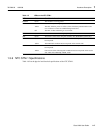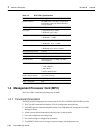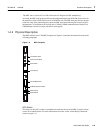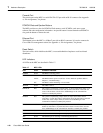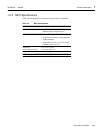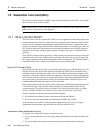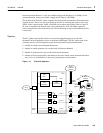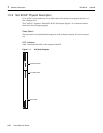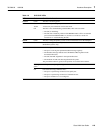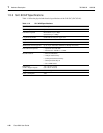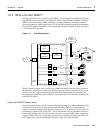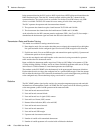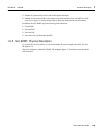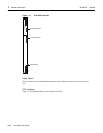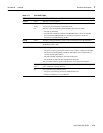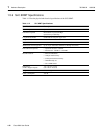
1 Hardware Description 78-5296-02 10/02/98
Cisco 6200 User Guide1-28
In the upstream direction, the SLC receives ADSL signals from a POTS splitter and demodulates the
DMT-modulated signal. Then the SLC channel contends with the other SLC channels for the
upstream data bus. Two priority levels are available. For the first Cisco 6200 release, only UBR
service is available. The SLC will ensure fair access among all cells of the same priority.
The SLC separates the upstream and downstream data channels:
• The upstream data channel occupies a band between 25.875 kHz and 138 kHz.
• The downstream data channel takes the band between 138 kHz and 1.104 MHz.
At the subscriber site, the DSL customer premises equipment (CPE)—the Cisco 676, for example—
demodulates the downstream signal and sends the data to the subscriber’s PC.
Transmission Rates and Modem Training
Two modes are available for setting transmission rates:
• Rate-adaptive mode: You can set the subscriber ports to adapt (train) automatically to the highest
line speed attainable for the configured signal-to-noise ratio (SNR) margin for each direction.
• Explicit rate mode: You can set SNR margins and transmission speeds explicitly. Upstream and
downstream speeds can be set separately.
You can mix rate-adaptive and explicit modes on the same circuit, using one mode for upstream
traffic and the other for downstream traffic.
Rates available for downstream traffic range from 32 kbps to 8.032 Mbps, in increments of 32 kb
(32 kbps, 64 kbps, 96 kbps, 128 kbps, and so on). Rates available for upstream traffic start at 32 kbps
and increase in 32-kb increments to a maximum upstream rate of 864 kbps.
The modems on the SLC 8DMT train simultaneously in the upstream and downstream directions.
Each modem first tries to train at the configured rate at a specified SNR margin. If the first attempt
fails in either direction but a CPE is detected, the modem tries to train at the highest rate possible (up
to the configured rate). The modem keeps trying to train until it is successful.
Statistics
The SLC 8DMT gathers signal quality statistics for network management purposes and sends this
information to the management system via SNMP. The SLC reports each of the following statistics
to the management system for both upstream and downstream traffic:
• Near and far end uncorrected blocks
• Near and far end corrected blocks
• Near and far end loss of signal (LOS) counter
• Near end loss of frame (LOF) counter
• Remote failure indication (RFI, or far end LOF)
• Near and far end errored seconds
• Near and far end attenuation
• Near and far end SNR margin
• Upstream and downstream actual rates
• Number of nonidle cells transmitted downstream
• Number of nonidle upstream cells received with valid header checksum



